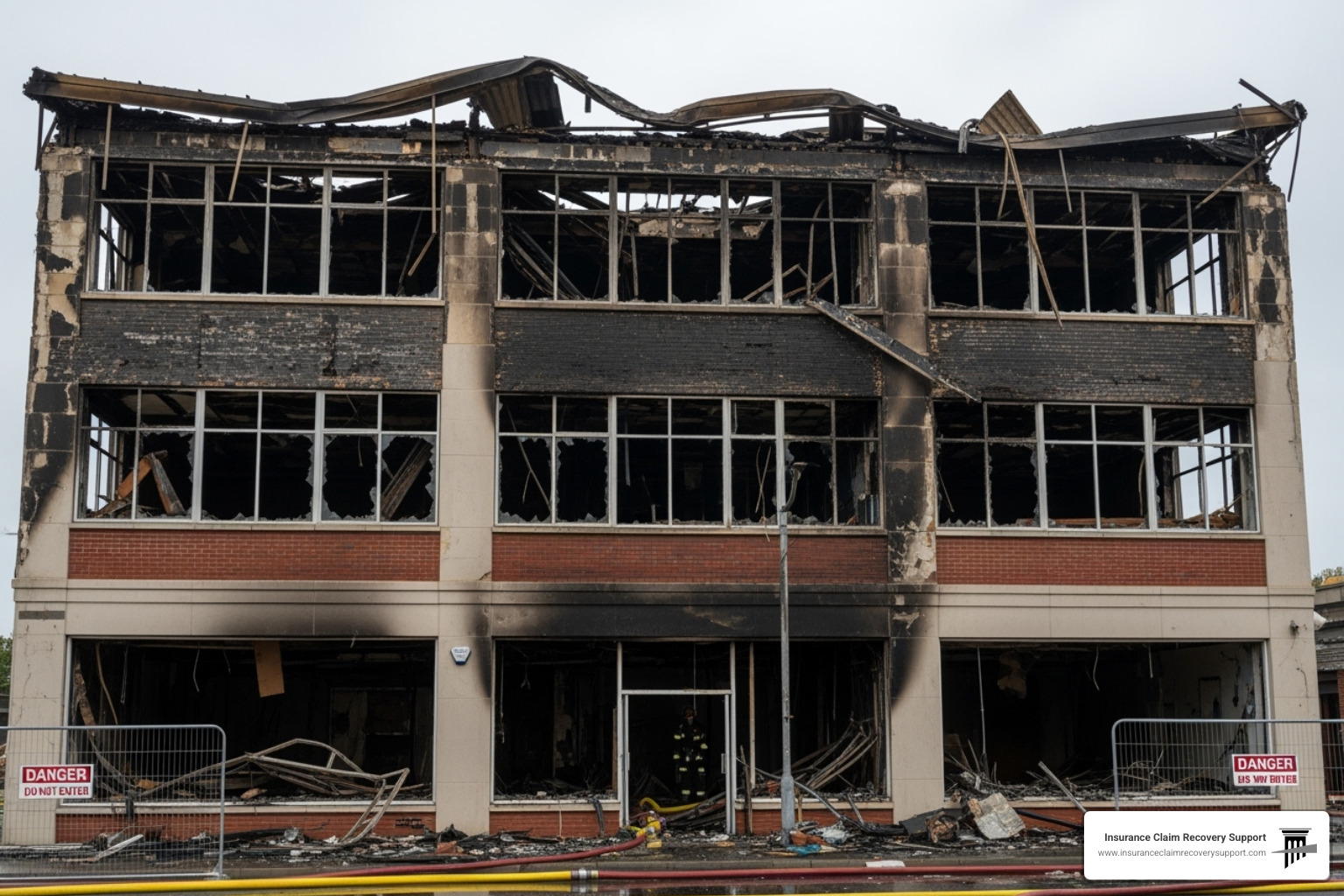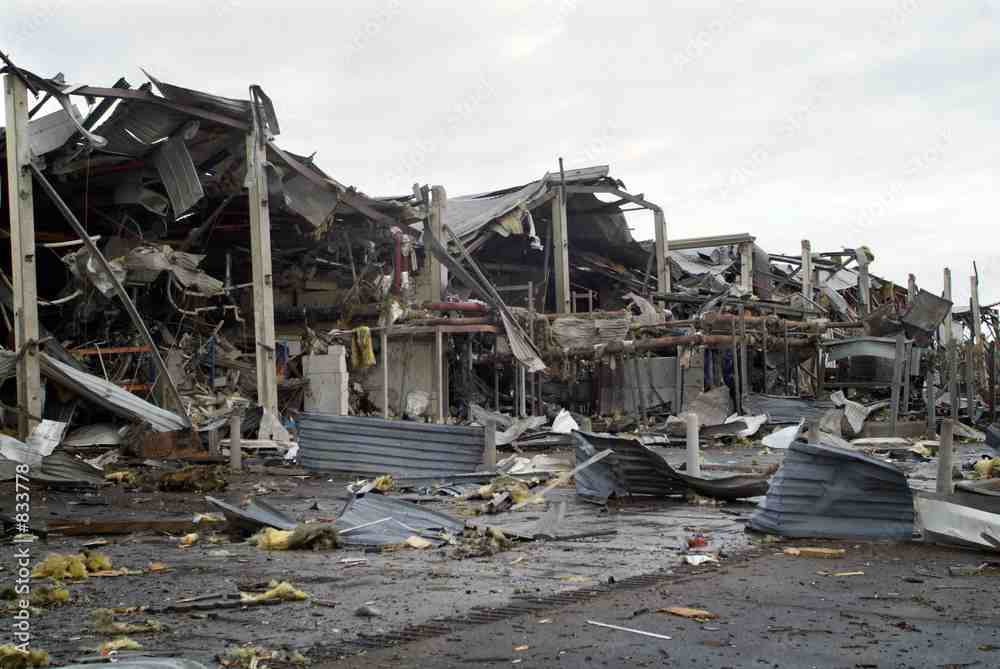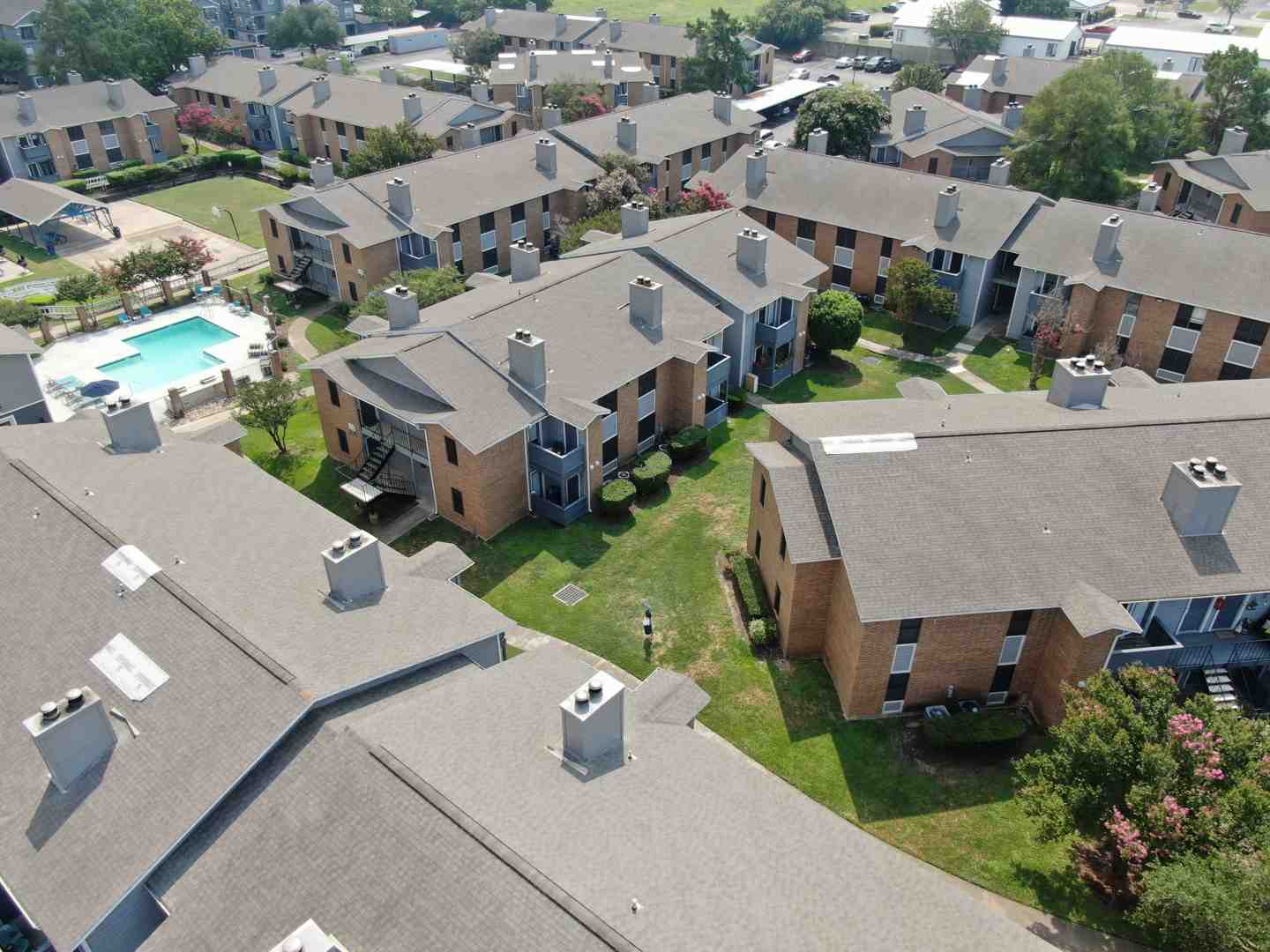When Disaster Strikes: The Reality of Filing a Business Fire Damage Claim
A business fire damage claim is one of the most complex challenges a property owner can face. The aftermath isn’t just about fire damage; it includes extensive smoke contamination, water damage from firefighting, and structural issues that may not appear for months.
Quick Answer for Business Fire Damage Claims:
- Secure the property – Board up, fence off, and prevent further damage.
- Document everything – Take photos, videos, and a detailed inventory of all damage.
- Notify your insurer immediately – Report the loss within your policy’s timeframes.
- Don’t sign anything – Avoid binding agreements without an expert review.
- Consider hiring a public adjuster – Level the playing field with the insurance company.
According to the National Fire Protection Association (NFPA), fires in non-residential structures cause billions in property damage annually. Beyond the financial toll, owners face the stress of potential ruin, the pressure to pay employees, and the daunting task of navigating a complex insurance claim while trying to rebuild.
The reality is that insurance companies are businesses focused on minimizing payouts. Most property owners have no experience with large fire claims, so initial settlement offers are often far lower than what is deserved. The process involves intricate policy language and strict deadlines that can trap the unprepared.
This guide walks you through each step of filing a successful business fire damage claim, from the first hours after the fire to negotiating a fair settlement.
As the founder of a public adjusting firm that has handled over 500 large loss claims valued at more than $250 million, I’ve seen how a knowledgeable advocate can be the difference between a successful recovery and a devastating financial loss. We’ve helped policyholders recover millions in previously denied or underpaid settlements, and this guide shares that experience with you.
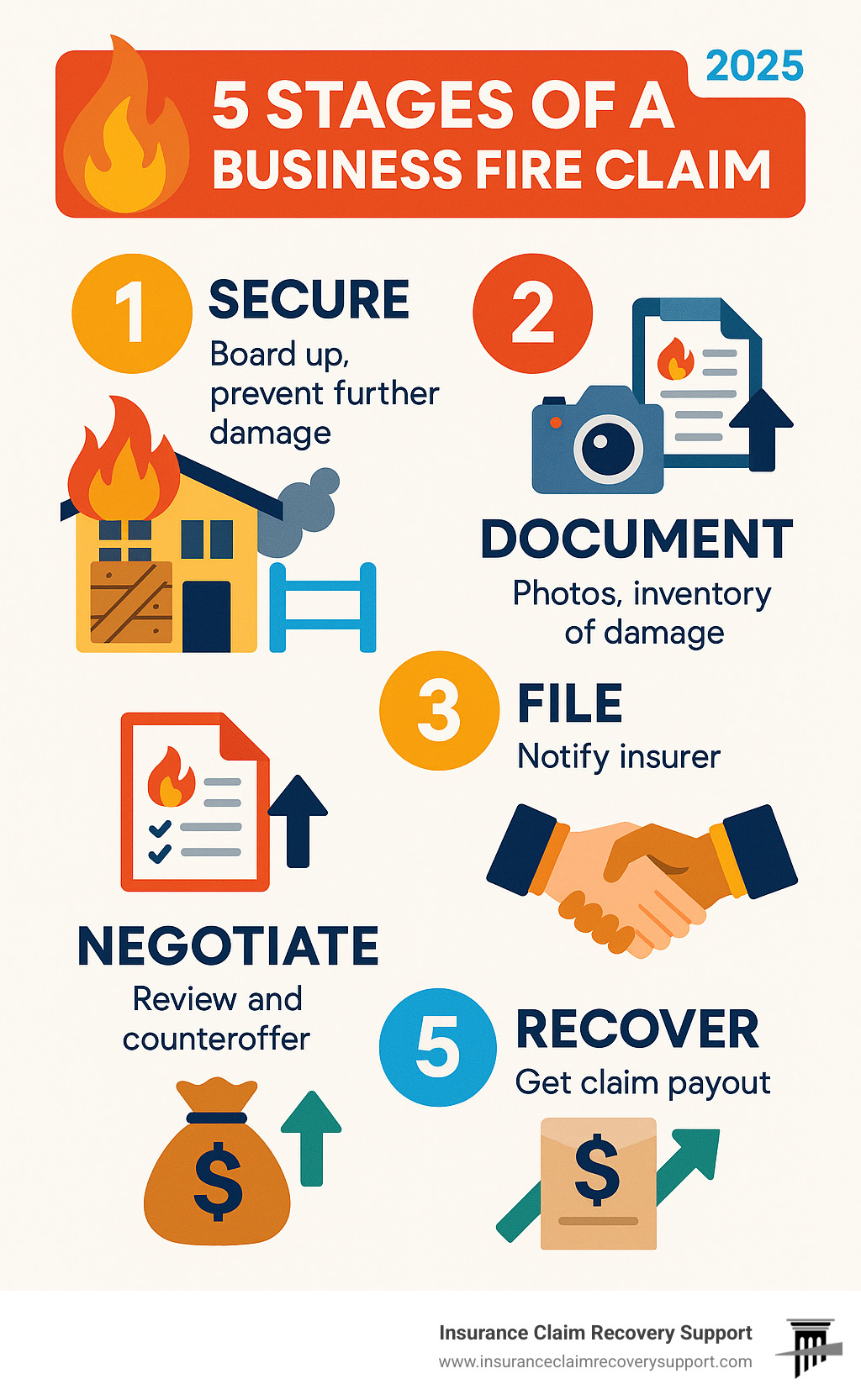
Learn more about business fire damage claim:
First Steps After a Business Fire: Secure, Mitigate, and Notify
In the first hours after a fire, your actions set the foundation for your entire business fire damage claim. It’s overwhelming, but focus on these critical steps.
Safety comes first. Do not enter the building until emergency services give the all-clear. The fire department report is a crucial piece of evidence for your claim, so be sure to get a copy.

Once it’s safe, your next mission is to secure the property. Board up broken windows, secure damaged doors, and set up temporary fencing if needed. This prevents theft and stops weather from causing more damage.
Mitigating further damage is your responsibility. A single fire sprinkler head can release 60 gallons of water per minute, leading to flooding and mold. Address standing water immediately. Soot and smoke are also corrosive and will continue to damage property if left untreated. Do not try to clean smoke damage yourself, as improper methods can set stains permanently. Professional mitigation is essential.
Next, notify your insurance company immediately. When you call, simply report that a fire occurred. Do not sign anything from the insurance company without an expert review.
Understanding Your Immediate Duties
Your insurance policy requires you to take reasonable steps to mitigate further damage. This is not a suggestion; it’s a contractual duty. If you fail to protect your property from additional harm (e.g., not tarping a damaged roof before a rainstorm), your insurer could deny coverage for any subsequent losses. Document every penny you spend on mitigation. Receipts for tarps, boarding materials, and emergency repairs are often reimbursable, but only with detailed records.
What Does a Claims Adjuster Do? can help you understand who you’ll be dealing with, and our guide on How to Steer Commercial Property Claims in 5 Easy Steps provides a roadmap for the process.
Notifying Your Insurer Correctly
Most policies have strict notification deadlines, sometimes as short as 24-72 hours. Missing them can jeopardize your business fire damage claim. When you call, provide the date, time, address, and a simple description of the event. You’ll get a claim number—keep it handy for all future communication.
A costly mistake is speculating. If you don’t know the cause or full extent of the damage, don’t guess. Stick to verifiable facts. Insurers can use your words against you. An innocent comment like, “I think it started near the electrical panel,” could be twisted into grounds for denial. Simply state that “a fire occurred” and let the professionals investigate.
For more guidance, see our resource on Business Insurance Claims. Keep your initial report factual and simple.
A Comprehensive Guide to Your Business Fire Damage Claim
After securing the property and notifying your insurer, the real work of building your business fire damage claim begins. This requires becoming a documentation expert.
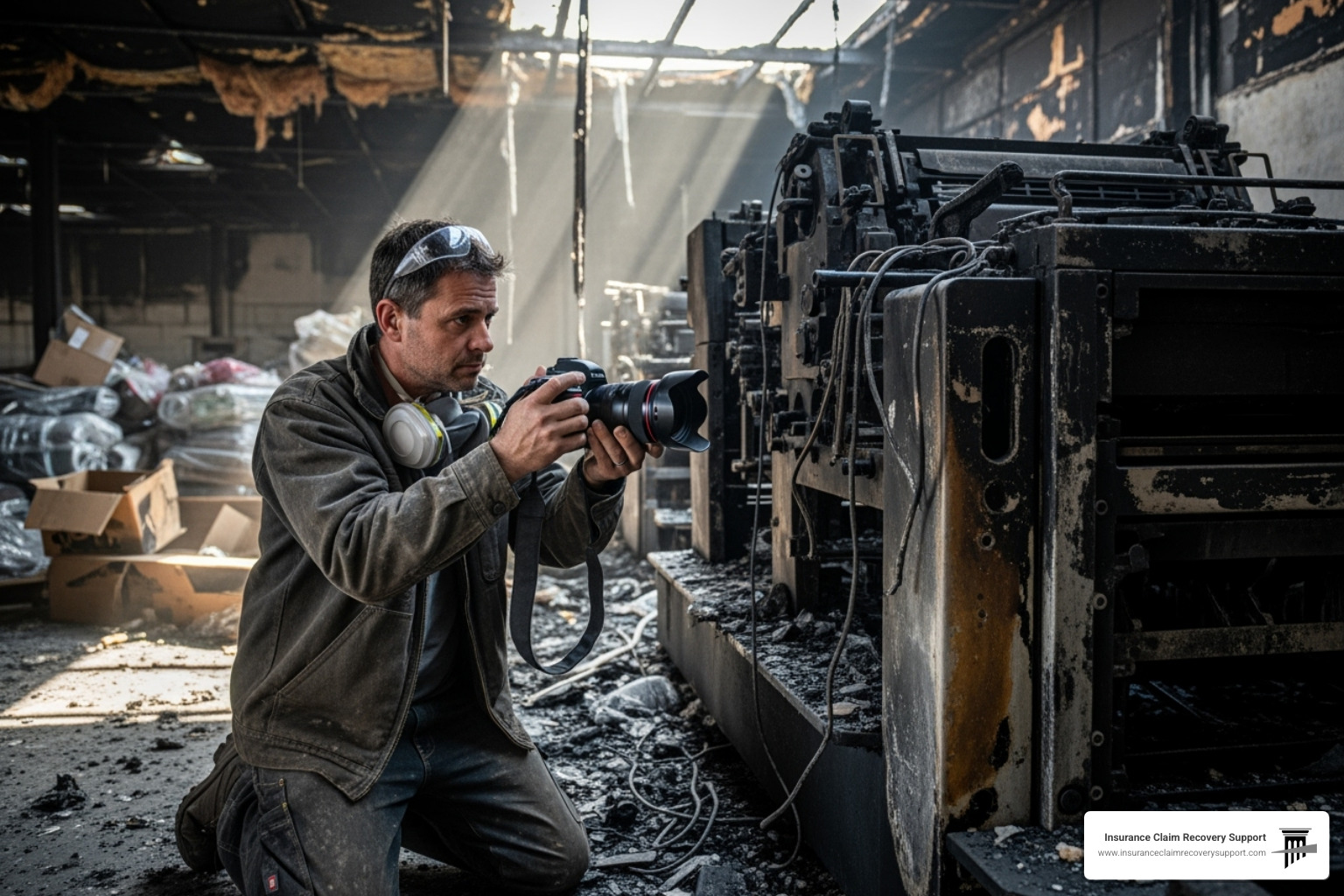
Photographic and video evidence is your best tool. Start with wide shots showing the overall scope of damage, then move to detailed close-ups from multiple angles. Ensure your camera’s timestamp is accurate.
Creating a detailed inventory of your Business Personal Property (BPP) is essential. Document every piece of machinery, every computer, and all raw materials. For destroyed items, gather “before” photos, purchase receipts, and warranty information. Our Large Loss Claim Documentation Lists can help you tackle this systematically.
Structural damage goes beyond what’s visible. Fire can weaken a building’s core integrity, making it unsafe even if it looks stable. Hidden damages are often the most expensive. Smoke and soot seep behind walls and under floors, while water from firefighting can cause mold weeks later. If your building is older, the fire may have disturbed materials containing asbestos, a serious health hazard. Learn more about this issue in our guide on Asbestos Fire damage. Also, don’t forget your HVAC systems, as contamination can spread through air ducts, requiring specialized cleaning.
For Commercial Building Owners, understanding these nuances is critical to avoid paying for hidden damages out of pocket.
Calculating Business Interruption and Extra Expenses
Business Interruption coverage is the lifeline that keeps your business financially viable while you rebuild. It compensates you for lost income and covers continuing operating expenses like payroll, rent, and utilities. Extra Expense coverage pays for additional costs to keep your business running, such as temporary relocation or renting replacement equipment.
Calculating these losses is complex. It requires analyzing historical financial data, seasonal variations, and growth trends. The complexity often necessitates a forensic accountant to reconstruct your financial picture and project what your business would have earned if the fire hadn’t occurred. Accurate calculations are crucial, as we explore in A Closer Look at Luxury Real Estate Insurance Claims.
Documenting for a Large or Complex Business Fire Damage Claim
For a What Is a Large Loss Claim?, the documentation requirements are even more demanding. You must prove the exact value of what was lost and what it will cost to replace. This means gathering receipts, invoices, blueprints, and records showing the property’s pre-loss condition. You may need to work with structural engineers and other specialists. A thoroughly documented claim file strengthens your negotiating position, which is vital for all commercial properties, including Apartment and Multifamily Claims.
Navigating the Claims Process: Policy, Adjusters, and a Fair Fight
With your documentation organized, you enter the negotiation phase of your business fire damage claim. Understanding your policy and who represents your interests is critical.
Your insurance policy is a legal contract written in complex language. It’s vital to have it reviewed by an expert. You must understand key terms like Actual Cash Value (ACV), which pays for your damaged property minus depreciation, and Replacement Cost Value (RCV), which covers the cost to replace items with new ones. The difference can be hundreds of thousands of dollars. Also, be aware of your policy limits, deductible, coinsurance penalties, and Ordinance or Law coverage, which pays for required code upgrades.
Our Glossary of Property Insurance Claim Terms can help decode this jargon.

The Company Adjuster vs. Your Public Adjuster
The adjuster sent by your insurance company works for them. Their primary loyalty is to their employer’s bottom line, which means minimizing claim payouts. It’s simply how their business works.
This is why Public Adjusters exist. We work exclusively for you, the policyholder. Think of it this way: you wouldn’t let the opposing side’s lawyer represent you in court. The same logic applies to your insurance claim. We level the playing field with our expertise in policy interpretation, damage assessment, and negotiation.
We identify hidden damages, prepare comprehensive documentation to support your claim’s true value, and negotiate fiercely on your behalf. To see the impact, read How Public Adjusters Can Transform Your Commercial Claim. For fire-specific expertise, visit our page on Public Insurance Claims Adjuster for Fire Damage.
Why You May Need a Texas-Based Public Adjuster
While we serve clients nationwide, local expertise matters. Texas has unique insurance regulations and claim challenges. The Texas Department of Insurance sets specific guidelines for how claims are handled. Whether your business is in Austin, Dallas, Houston, San Antonio, or smaller communities like Lubbock, San Angelo, Waco, or Round Rock, we understand the local landscape.
As one of the leading Public Adjusting Firms Texas USA, our commitment is to Public Service Adjusting that puts your recovery first. You can verify our license via the Texas Public Adjuster License Lookup. Having a Texas Public Adjuster who knows these local nuances can make a significant difference in your final settlement.
Maximizing Your Settlement: Negotiation and Avoiding Common Pitfalls
After submitting your business fire damage claim, the insurance company will make an initial offer. This is rarely their best offer. Don’t settle too quickly.
Get multiple repair estimates from reputable, specialized contractors. This provides a strong basis for negotiation. With documented evidence, you can counter the insurer’s offer with a claim package that supports your true losses. Common pitfalls to avoid include:
- Inadequate Documentation: Weak proof makes it hard to argue for a higher settlement.
- Settling Too Quickly: Insurers count on you giving up. Their first offer is a starting point.
- Missing Unseen Damages: Smoke, soot, and water damage can cause long-term issues like mold if not properly addressed and claimed.
Dealing with Underpaid or Delayed Claims
It’s common for insurers to deny, undervalue, or delay claims. If your business fire damage claim is stuck, you are not alone. These bad faith tactics can include unreasonable delays, lowball offers, and disputes over the scope of loss.
You have rights as a policyholder. If you have an Underpaid Delayed Insurance Claim, we can help you understand your options. While you can File a Complaint Against Your Insurance Company yourself, a public adjuster significantly increases your chances of a fair outcome.
For more on the commercial claims process, review our guide on how to steer commercial property claims.
Frequently Asked Questions about Business Fire Damage Claims
After a fire, it’s normal to have questions. Here are answers to the most common concerns we hear from business owners.
What are the biggest mistakes businesses make when filing a fire claim?
Inexperience with major claims can be costly. The most common mistakes include:
- Rushing Decisions: Accepting the first offer or making quick repair choices under pressure without understanding the long-term consequences.
- Poor Documentation: Failing to take detailed photos, videos, and inventories of all damaged property. Your documentation is the backbone of your claim.
- Trusting the Insurer’s Adjuster: The company adjuster works for the insurance company, not you. Their goal is to minimize the payout.
- Discarding Damaged Items: Never throw anything away until it has been inspected and documented by all parties. Once it’s gone, you have no proof of loss.
- Not Understanding the Policy: Being unaware of coverage limits or the difference between ACV and RCV can lead to financial shock.
- Settling Too Soon: The first offer is almost never the best offer.
- Not Hiring a Public Adjuster: For a major business fire damage claim, not having a professional advocate is a significant risk. If you’re wondering if a Public Adjuster Needed, the answer is almost always yes.
How is “Business Interruption” calculated in a claim?
Business Interruption coverage aims to restore your business to the financial position it would have been in without the fire. The calculation is complex but generally includes:
- Lost Net Profit: The income your business would have earned during the “period of restoration” (the time it takes to rebuild and resume operations).
- Continuing Operating Expenses: Costs that continue even when you’re shut down, like payroll for key employees, rent, and utilities.
The calculation relies on historical financial data (P&L statements, tax returns) and future business projections to account for growth or seasonal trends. This often requires expert analysis from a forensic accountant to create a bulletproof claim.
What is the difference between Replacement Cost Value (RCV) and Actual Cash Value (ACV)?
This is a critical distinction in your business fire damage claim. Understanding it can dramatically affect your settlement.
| Feature | Replacement Cost Value (RCV) | Actual Cash Value (ACV) |
|---|---|---|
| Definition | Cost to replace damaged property with new, similar property. | Replacement cost minus depreciation (age, wear, tear). |
| Payout | Typically paid in two stages: ACV first, then RCV upon repair/replacement. | Paid upfront based on depreciated value. |
| Goal | Restores property to its pre-loss condition without deduction for depreciation. | Puts the insured in the financial position they were before the loss. |
| Impact | Higher potential payout, allows for full replacement. | Lower payout, may not cover full cost of new items. |
In short, RCV pays to replace your property with new items, while ACV pays the depreciated value. For example, RCV would buy you a new computer system, while ACV would give you cash for your five-year-old system. Most businesses need RCV coverage to fully recover. Typically, you receive the ACV amount first, and the rest is paid after you complete the repairs or purchase replacements.
Conclusion: Rebuilding Your Business with the Right Support
Recovering from a business fire is a monumental task, but it is not the end of your story. Filing a business fire damage claim is complex, and insurers often count on policyholders being too overwhelmed to fight for a fair settlement. Don’t let them win.
You don’t have to fight this battle alone. The path to recovery—from securing your property and documenting damage to negotiating your settlement—requires expertise that most business owners don’t have. You shouldn’t have to become an insurance expert while also trying to rebuild your company.
At Insurance Claim Recovery Support, we are advocates who fight exclusively for policyholders. We don’t work for insurance companies; we work for you. We take the burden of the claims process off your shoulders, allowing you to focus on getting your business back up and running. The difference we make in a final settlement often pays for our services many times over.
Don’t let an unfair insurance settlement burn you twice. Take the first step toward the fair recovery you deserve. Learn more about our work by visiting Our Clients.
Your business can come back stronger than ever. Let us help you make that happen.


